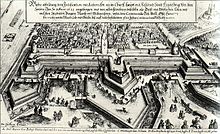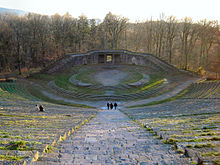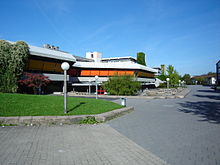History of Heidelberg
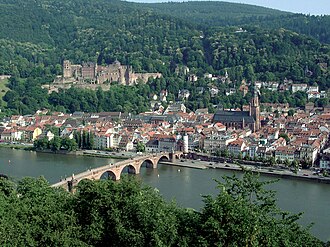
The history of Heidelberg extends beyond the first documented mention of the city in 1196 to settlements in the Heidelberg city area at the time of the Celts and Romans . In the 13th century was the castle , the town was laid out according to plan and the residence of the Count Palatine of the Rhine . This marked the beginning of the five hundred year heyday of the city on the Neckar as the capital of the Palatinate . The University of Heidelberg was founded in 1386 as the first university in today's German territory. In the Palatinate War of Succession , French troops destroyed the city in 1693, which was rebuilt on a medieval floor plan in the Baroque style. In 1720 the electoral residence was relocated to Mannheim . In 1803 Heidelberg came to Baden . In the 19th century, poets and thinkers worked in the city who earned Heidelberg the nickname "City of Romanticism ". Heidelberg became a science location and travel destination. In the 19th and 20th centuries, the city was enlarged through incorporations and building projects and remained largely undestroyed in the Second World War . After the end of the war, Heidelberg was the location of the headquarters of the American land forces in Europe until 2013 .
Before the city was founded
prehistory

An ancestor of the Neanderthal man , the prehistoric man Homo heidelbergensis , got its name from the place where it was found southeast of Heidelberg. In 1907, the worker Daniel Hartmann found a 600,000 year old lower jaw , the type specimen of a Homo heidelbergensis, in a sand pit near Mauer . This lower jaw is one of the oldest prehistoric man finds in Europe.
The first permanent settlement of the Heidelberg area can be proven for the Neolithic Age through archaeological finds from the 5th millennium BC, which can be assigned to the Bandkeramik , Rössen and Michelsberg cultures . During the Bronze Age , members of the tumulus and urn field culture settled in the Heidelberg area.
Celtic time
From around 500 BC The Celts appear in the history of Heidelberg . Members of the Helvetii tribe founded a larger fortified settlement on the Heiligenberg . Its double ring wall can still be seen. Two hundred years later this facility was abandoned for reasons that were not entirely clear. In the 1st century BC The Helvetii left the Heidelberg area under the pressure of the advancing Germanic tribe of the Suebi under Ariovistus and tried to gain a foothold in Gaul . After the Helvetii 58 BC Were defeated by the Romans under Julius Caesar in the Battle of Bibracte , the Upper Rhine Plain remained largely deserted.
Roman rule
During the reign of Emperor Tiberius (14–37 AD), the Romans settled allied Teutons from the Neckarsueben tribe in the area east of the mouth of the Neckar to create a buffer zone between the Rhine , the outer border of the Roman Empire, and Germania . Under Emperor Vespasian (69–79), the Romans pushed their border into the area on the right bank of the Rhine and also founded a military camp in what is now Heidelberg's urban area. In the year 90 a stone fort was built in place of the previous wooden structures. The Romans first built a wooden bridge over the Neckar, then finally a 260 m long stone pillar bridge around the year 200. A Mercurius temple was built on the summit of the Heiligenberg , and the Mithras cult was also widespread in Heidelberg. In Roman times the main town of the region was the neighboring Lopodunum (today Ladenburg ), but a flourishing pottery center also developed around the military camp in Heidelberg (whose Latin name is unknown).
In the 3rd century the Romans were ousted by the Alamanni . The Germanic tribe broke through the Limes from 233 and invaded Roman territory. In the Heidelberg area, too, there were frequent attacks and arson. After 260 the Romans had to retreat to the Rhine , and the Alamanni finally settled in the Roman border region in what is now south-west Germany.
Franconian Empire and Christianization

Little is known about the history of Heidelberg in the following centuries. With the victory of the Merovingian King Clovis I over the Alamanni in 506, Heidelberg finally became part of the Franconian Empire and belonged to the Lobdengau . The most visible consequence of the new rule was the Christianization of the area. In the 8th century, the nearby Lorsch Monastery developed into an important political center, which struggled with the diocese of Worms for supremacy in the region. In order to consolidate his influence in the Heidelberg area, the Lorsch abbot Thiotroch had the Michaelskloster founded as a subsidiary monastery on the Heiligenberg in 870 on the site of the old Mercury temple . Two centuries later, another branch, the St. Stephen's Monastery, followed on the Michelsberg, the foothills of the Heiligenberg . In 1130 the Neuburg Abbey was built at the foot of the mountain.
Many of Heidelberg's villages were built as early as the Frankish period in the 6th century. They are first mentioned in the 8th century in the Lorsch Codex - Neuenheim and Handschuhsheim in 765, Rohrbach 766, Wieblingen and Kirchheim 767 and Bergheim in 769. The districts of Heidelberg that go back to these villages are several centuries older than the city itself.
Heidelberg in the Middle Ages
Beginnings of Heidelberg

The name Heidelberch is mentioned for the first time in a document from the Schönau monastery from 1196. At that time, the place was still owned by the diocese of Worms . A castle on the north slope of the Königstuhl was built at the end of the 11th or beginning of the 12th century. It is unclear whether this first castle was a predecessor of today's Heidelberg Castle on the Jettenbühl , or whether it was located on the Molkenkur at a higher point on the mountain slope and the previous building of the castle was only built in the 13th century. In any case, it is certain that today's castle has nothing in common with the first construction phase due to numerous renovations and extensions. Below the castle was a small hamlet in the area around the Peterskirche , the oldest church in Heidelberg's old town.
The name Heidelberg originally referred to the castle and was later transferred to the city, but the etymology is not entirely clear. The "mountain" in the name should refer to the Königstuhl. The first component could be derived from the landscape term “ heath ”, which means something like free land in the sense of uninhabited community area. The modern use of heather in the sense of an unwooded area can also be justified, as the earliest images of the Königstuhl depict its top unwooded. However, it is less likely that Heidelberg is derived from “Heidenberg” and refers to the Celtic and Roman worship of gods on the Heiligenberg. The derivation of the Old High German personal name Heidilo has also been rejected. A derivation of the city name from the fruit blueberry is legend and also hardly likely because the corresponding name is not known in the local dialect and is called blueberry there.
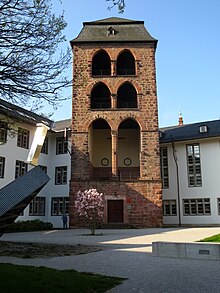
The actual city of Heidelberg was only planned later in the area between Königstuhl and Neckar . While it was long assumed that Heidelberg was founded between 1170 and 1180, more recent findings suggest that the city was only founded around 1220. The right-angled floor plan with three streets running parallel to the river and connecting cross streets and the market square in the center has been preserved to this day. This urban complex took up the eastern part of today's old town , known as the core old town, up to Grabengasse. It was surrounded by a city wall, of which only the so-called witch tower in the courtyard of the New University remains. A bridge over the Neckar is first mentioned in 1284. Although it was to remain the main church of Heidelberg for a long time, the Peterskirche and the surrounding old castle hamlet, later called Bergstadt, were outside the city limits until the 18th century.
Ascent to the royal seat of the Electoral Palatinate
Emperor Frederick I Barbarossa had his half-brother 1156 Konrad the Staufer to Palatine appointed by Rhine. Count Palatine already existed in Franconian times, originally the Count Palatine were senior royal officials at court with predominantly administrative and judicial tasks. Under Konrad, the northern Upper Rhine region became the center of the Palatinate, which over time developed into a larger territorial state within the Holy Roman Empire . After a short reign of the Welfs , the office went to the Wittelsbach dynasty in 1214 . In 1225, the Count Palatine received the former Worms Heidelberg as a fief .
At the beginning of their reign, the Count Palatine did not have a permanent residence, but stayed in different places on their territory. But already under Ludwig II (1253–1294) Heidelberg had developed the character of a royal seat. When the traditional travel rule was given up in the 14th century, Heidelberg established itself as a residence .
In the house contract of Pavia in 1329, the Wittelsbach dominion was divided between a Palatinate and a Bavarian line. The electoral dignity , the right to elect the Roman-German king , should switch between the two lines according to the treaty. In the Golden Bull in 1356, however, only the count palatine near Rhine received the electoral dignity. From now on they were known as Electors of the Palatinate and were among the most influential German rulers. In the period that followed, people began to call their territory the Electoral Palatinate .
University foundation
In 1386, Elector Ruprecht I founded the University of Heidelberg . After the universities of Prague (founded in 1348) and Vienna (1365) it was only the third university in the Holy Roman Empire; of the universities in what is now the Federal Republic of Germany, it is the oldest. With the establishment of the university, Heidelberg experienced an increase in importance, not least because it helped establish Heidelberg as the royal palace of the Electoral Palatinate. Ruprecht's political ambitions may have played a role as the motivation for founding the university, as he was able to build a considerable reputation for Heidelberg and the Electoral Palatinate through the promotion of science and at the same time to train the clergy, medical practitioners, lawyers and teachers needed to manage his territory to let. Another important reason, however, was that after the Great Western Schism , German academics could no longer study at the Paris Sorbonne , the leading European university of the Middle Ages, because Germany became Pope Urban VI. held in Rome, while in France the Avignon antipope Clement VII was supported.
Although the city on the Neckar was remarkably small for a university town with just 5,000 inhabitants at the time the university was founded and also lacked any academic tradition, and other university foundations such as Cologne (1388) competed with it, the Heidelberg “Hohe Schule “Claim as a medium sized university. The university had its own jurisdiction and its members enjoyed numerous privileges. There were several violent clashes between the urban population and the university students in the course of the 15th century. Full class struggles, as they were the order of the day in the great imperial cities , did not materialize in Heidelberg.
City expansion and subsequent development
Under Elector Ruprecht II , an extensive city expansion took place in Heidelberg in 1392. The western city limits were extended to the height of today's Bismarckplatz , thus doubling the area of Heidelberg. The inhabitants of the village of Bergheim were forcibly relocated to the newly created suburb. The urban area had now been given an expansion that corresponds to today's old town and was to last into the 19th century. The area of the suburbs remained very loosely developed for a long time. At the same time as the city was expanded, the Jews who had lived in the city since the 13th century were expelled from Heidelberg. Her synagogue was converted into a Lady Chapel, which also served as the university's auditorium.

In 1400, Elector Ruprecht III. elected Roman-German king as the first and only Elector of the Palatinate. Even if Ruprecht's imperial policy was not always fortunate, his royal seat, Heidelberg, benefited from his royal dignity. The Ruprechtsbau , the oldest surviving part of the castle, was built at Heidelberg Castle . Ruprecht also had the chapel on the market square expanded into a representative Church of the Holy Spirit . The Heiliggeistkirche replaced the Peterskirche as a parish church and became the burial place of the Palatinate electors. Ruprecht's successor Ludwig III. bequeathed his private library to the Heilig-Geist-Stift and thus created the basis for the famous Bibliotheca Palatina , which was kept in the galleries of the church.
Elector Friedrich I (1451–1476), popularly known as "Pfälzer Fritz", enlarged the territory of the Electoral Palatinate in several successful military campaigns that earned him the nickname "the Victorious" and carried out reforms at Heidelberg University. Under him and his successor Philipp (1476–1508) the university became a stronghold of Renaissance humanism , where scholars such as Peter Luder , Johann XX. von Dalberg and Rudolf Agricola worked. Although Luder soon left Heidelberg again, his inaugural address on the Studia humanitatis in 1456 is considered to be the beginning date of humanism in Germany.
Despite court aristocrats and academics, Heidelberg remained an agrarian town in the Middle Ages . The citizenship was organized into ten guilds , of which the winegrowers was the largest.
Reformation and Wars
Lutheranism and Calvinism
Martin Luther's appearance at the Heidelberg disputation in 1518 helped to make the ideas of the Reformation known throughout Germany. Luther's ideas also spread at the Kurpfälzer Hof. The Electoral Palatinate, however, was not actively involved in the Reformation, even if the Palatinate electors at least tolerated the Reformation movement in the first half of the 16th century. Elector Friedrich II. (1544–1556) meanwhile switched to a reformatory policy, but had to return to Catholicism under pressure from the emperor. It was only under Elector Ottheinrich (1556–1559) that the Electoral Palatinate finally became Lutheran. Ottheinrich released the University of Heidelberg from the influence of the Catholic Church and combined the book holdings of the university, the monastery library in the Heiliggeistkirche and the castle library of the Electors to form the Bibliotheca Palatina. With the construction of the Ottheinrichsbau , the first Renaissance building in Germany, he continued the conversion of the electoral residence from a rather unadorned castle to a splendid palace, which his predecessors had begun.
After Ottheinrich introduced Lutheranism, the Electoral Palatinate changed its denomination a total of seven times up to the 18th century, following the principle of cuius regio, eius religio (“whose rule, whose religion”). Ottheinrich's successor, Friedrich III. (1559–1576) turned to Calvinism . He made the Electoral Palatinate into a strictly Calvinist state, in whose churches there was a strict ban on images and cursing was a punishable offense. The importance of Heidelberg as a stronghold of the Reformed faith becomes clear in the Heidelberg Catechism , which was created in 1563 and is still a pioneering creed of the Calvinists. Under the next Elector Ludwig VI. (1576–1583) Heidelberg returned to Lutheran Protestantism before the administrator Johann Casimir (1583–1592) reintroduced Calvinism. With every change the university was purged of unsuccessful professors. Friedrich IV. (1592–1610) built the Friedrichsbau named after him on Heidelberg Castle.
Thirty Years' War

Under the rule of Elector Friedrich V (1610–1623), Heidelberg first experienced a period of courtly splendor. In order to be able to offer his wife, the English king's daughter Elisabeth Stuart , a court life befitting their rank, Friedrich had the Heidelberg Castle redesigned. The prelude was the completion of the early baroque English building and the Elizabeth Gate . A little later, work began on creating the famous Hortus Palatinus , a magnificent palace garden based on French and Italian models - but it was never completed.
On the political front, however, Frederick's rule was to end in a debacle. As leader of the Protestant Union , he tried to make the Electoral Palatinate the Protestant supremacy in the Holy Roman Empire. After the lintel in Prague , which triggered the Thirty Years' War in 1618 , the Bohemian estates deposed the Catholic Ferdinand II and elected Frederick as King of Bohemia on August 26, 1619. Friedrich had hesitated to accept the crown because he feared that he would not be able to assert himself militarily against the Habsburgs . In fact, he was only able to maintain his rule for thirteen months, and so he went down in history under the derisive name of "Winter King". On November 8, 1620, he was defeated by the troops of the Emperor and the Catholic League in the Battle of White Mountain and had to flee into exile in the Netherlands. The emperor revoked Friedrich V's electoral dignity and transferred it to Duke Maximilian of Bavaria .
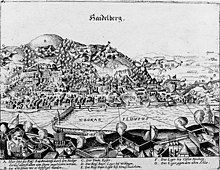
In the summer of 1621, General Tilly's army, supported by Spanish troops, set out to conquer the Palatinate . After a siege that lasted almost three months, Heidelberg was captured on September 19, 1622. During the following Bavarian occupation, Catholicism was forcibly introduced and the university was dissolved. The Bibliotheca Palatina was shipped to Rome at the instigation of Maximilian and Pope Gregory XV. given. It is kept in the Vatican Library to this day . In 1631 the Swedes intervened in the war and in the meantime occupied the Electoral Palatinate. This made Heidelberg Protestant again for a short time before the imperial troops took the city again shortly afterwards.
In the Peace of Westphalia , which ended the Thirty Years' War in 1648, Frederick's son Karl I Ludwig received the downsized Palatinate and the revoked eighth electoral dignity back. However, the rulers of the Electoral Palatinate had lost much of their previous political weight, as they were now only in the last position in the line of electoral princes and had to forego the office of arch trustee . After Karl Ludwig, who grew up in English exile, moved to Heidelberg in October 1649, he arranged for the war-ravaged city to be rebuilt and settled immigrants from Reformed areas, including Switzerland. Karl Ludwig campaigned for a balance between the religions and recognized the Lutheran and the Reformed creed as having equal rights. In 1652 the university, which was dissolved during the Bavarian occupation, was reopened. The appointment of the lawyer Samuel von Pufendorf brought the university a reputation, even if the attempt to win Baruch Spinoza for the University of Heidelberg was unsuccessful.
War of the Palatinate Succession
In 1671, Karl Ludwig married his daughter Elisabeth Charlotte (better known as Liselotte von der Pfalz ) for political reasons with the French Duke Philip I of Orléans , a brother of the "Sun King" Louis XIV. Karl Ludwig's political calculation turned out to be fatal Prove misjudgment. Because after his son and successor Karl II died childless in 1685, the Pfalz-Simmern line of the Wittelsbach family became extinct . The electoral dignity was now transferred to Philipp Wilhelm , a representative of the Catholic side line Pfalz-Neuburg . For the French King Louis XIV, this was a welcome opportunity to assert the legacy of the Electoral Palatinate for himself with reference to his sister-in-law Elisabeth Charlotte. The Palatinate War of Succession (1688–1697) resulted from the French claims, which grew into a pan-European cabinet war.
The War of the Palatinate Succession was particularly devastating for Heidelberg, as the city was captured and devastated twice by French troops under Ezéchiel de Mélac . The French led the war, following new considerations of war theory, as a planned extermination campaign and proceeded in a targeted manner with enormous brutality. The first conquest in October 1688 was still relatively harmless, even though the town hall and the thick tower on the castle were blown up. In the meantime, the French had to retreat behind the Rhine, but in 1693 they pushed back into the Palatinate and took Heidelberg again. This time the entire city was reduced to rubble. Only a few buildings like the Haus zum Ritter survived the destruction. The castle fell into ruin when the French blew up its towers and walls.
Reconstruction and loss of residence
reconstruction
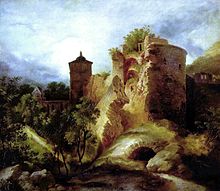
After the Peace of Rijswijk ended the War of the Palatinate Succession in 1697, the reconstruction of Heidelberg began under the aegis of Elector Johann Wilhelm . The old floor plan was retained and new baroque-style houses were built on the foundations of the destroyed buildings . To this day, the city has retained this face as a baroque city on a medieval floor plan. Religious freedom has prevailed since the Peace of Westphalia, but the now Catholic electors promoted Catholicism and settled Jesuits in Heidelberg . A whole Jesuit quarter with a Jesuit church , college and high school was built in the old town . As a result of the Counter Reformation, a third of the population of Heidelberg converted to the Catholic faith. The Marian column on the Kornmarkt and the numerous statues of the Madonna on the houses in the old town, with which wealthy Catholic citizens documented their confession, remind of the re-Catholicization of the city . Partition walls were built in many Reformed and Lutheran church buildings, which were now used as simultaneous churches by the Catholics. In the Heiliggeistkirche, for example, one was only removed again in 1936.
Loss of residence

Because the destroyed castle was uninhabitable, Johann Wilhelm resided most of the time in Düsseldorf , partly also in Weinheim . The Heidelberg Castle meanwhile hardly corresponded to the baroque taste of the time, which preferred spacious palace complexes based on the model of Versailles . The elector had already had his court architect Matteo Alberti work out plans for such a residence, which was to be built on the plain in today's Bergheim district . However, the plan failed because the Heidelberg citizens refused to finance the building of the palace.
Johann Wilhelm's younger brother and successor Karl III. Philipp then decided to create a new residence and, after a dispute with the Heidelberg Protestants about the use of the Heiliggeistkirche, moved the capital of the Electoral Palatinate to Mannheim in 1720 . There he had Mannheim Palace built and the city expanded. With its geometric floor plan, the “ square city ” of Mannheim corresponded far better to the baroque zeitgeist and the elector's interest in representation than medieval Heidelberg. Until the completion of the Mannheim Palace, Karl Philipp resided provisionally in Schwetzingen until 1728 . Heidelberg lost its position as a center of political power and suffered economically from the departure of the court. The university also sank into mediocrity after losing its residence, even though it was given a new main building in 1735 with the Domus Wilhelmina , now known as the Old University .
Under Elector Karl Theodor (1743–1799), the Electoral Palatinate experienced an economic and cultural heyday from which Heidelberg also benefited. Karl Theodor wanted to have the Heidelberg Castle repaired so that it could be used as a summer residence. After a devastating lightning strike in 1764, the castle renovation was stopped again. The most famous landmark of Heidelberg next to the castle goes back to the elector: the Karl-Theodor-Brücke, which was completed in 1788, better known as the Old Bridge . It was built as the ninth bridge in total at this point after the old stone pier bridge with a wooden superstructure had fallen victim to a flood with ice four years earlier, which also destroyed parts of the old town. As a thank you to the elector, the citizens of Heidelberg had the Karlstor built in 1781 .
As part of bathing
End of the Electoral Palatinate
After France annexed the parts of the Palatinate on the left bank of the Rhine in the First Coalition War after the Revolution of 1789, the history of the Electoral Palatinate finally ended with the Reichsdeputationshauptschluss of 1803. The areas on the right bank of the Rhine and thus also Heidelberg were added to Baden , which was soon to become a Grand Duchy . In the Congress of Vienna in 1815, the Kingdom of Bavaria was given the Palatinate on the left bank of the Rhine (the Electoral Palatinate had been ruled in personal union from Munich since 1777), while Baden's territorial gains were confirmed.
The Baden Grand Duke Karl Friedrich (1771-1811) was a supporter of the Enlightenment and promoter of science. The University of Heidelberg owed it to him for its revival to a renowned educational institution. Karl Friedrich reorganized the university and made it a state-funded educational institution. The University of Heidelberg was given a new name, which not only reminds of the founder Ruprecht I but also of the reformer Karl Friedrich: since then it has been known as "Ruprecht-Karls-Universität" or under the Latin form of the name "Ruperto Carola". In the 19th century illustrious names such as the philosopher Georg Wilhelm Friedrich Hegel , the historian Heinrich von Treitschke , the chemist Robert Wilhelm Bunsen and the physicists Hermann von Helmholtz and Gustav Kirchhoff taught in Heidelberg . The reputation of the professors gave the university a considerable influx of students.
Heidelberg romance

At the beginning of the 19th century, Heidelberg became one of the most important centers of German Romanticism . As early as 1798, Friedrich Hölderlin set a monument to the city in his Ode Heidelberg . As a result, in addition to the scenic charms of the Neckar city, it was above all the castle ruins that were particularly attractive to writers and romantic painters. After Jena had been the center of German early romanticism , a group was formed in Heidelberg from 1804 around the poet Ludwig Achim von Arnim and the writer Clemens Brentano , whose work is known as the " Heidelberg Romanticism ". In the field of Romantic painting, an artist circle around Carl Philipp Fohr , Karl Rottmann and Ernst Fries was created in Heidelberg, inspired by the Boisserée Collection .
- See also Heidelberg in poetry
Arnim and Brentano published a collection of German folk songs in Heidelberg between 1806 and 1808 under the title Des Knaben Wunderhorn . Another group of poets developed around Joseph von Eichendorff , who studied in Heidelberg from 1807 to 1808. At Heidelberg University, influential professors such as the rector Anton Friedrich Justus Thibaut , the lecturer Joseph Görres and the philologist Friedrich Creuzer were close to Romanticism. The dispute with the Heidelberg philologist Johann Heinrich Voss , who was opposed to Romanticism and, last but not least, criticized Des Knaben Wunderhorn for the unscientific methods of the publisher, ultimately led to Vossian rationalism prevailing at Heidelberg University and Heidelberg Romanticism to Came to a standstill.
Vormärz and Baden Revolution
During the pre- March period in the first half of the 19th century, both the Heidelberg students organized in student associations and some of the university's liberal professors spread national, liberal and democratic ideas. The philosopher Ludwig Feuerbach had a great impact when he held lectures critical of religion in Heidelberg at the invitation of the student body in 1848. Because the university did not want to provide him with any rooms, he had to switch to the town hall.
Under the influence of the February Revolution in France, the German March Revolution took its course in Baden. On March 5, 1848, liberal and democratic politicians from southwest Germany gathered in the Hotel Badischer Hof for the Heidelberg meeting . This provided significant impetus for the pre-parliament and thus for the constitution of the Frankfurt National Assembly . Heidelberg remained unaffected by the Hecker uprising in the first phase of the Baden Revolution , but numerous democratic associations emerged in the city. When the democratic student association was banned, the Heidelberg students moved to Neustadt an der Haardt in protest in July. After the failure of the Frankfurt National Assembly, the May uprising spread across Baden. The Prussian troops called for help by the Grand Duke of Baden also fought against liberal irregulars in Heidelberg and ultimately put down the uprising.
Tourism and university
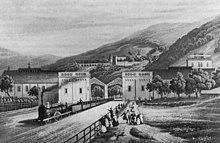
Even in the 19th century, the economy of Heidelberg - after all the fourth largest city in Baden - remained dominated by agriculture. The industrialization was much less far-reaching consequences for the Neckarstadt than about the neighboring Mannheim. Well-known industrial companies such as Waggonfabrik Fuchs , Heidelberger Druckmaschinen or HeidelbergCement were established in the city , but by the middle of the 19th century there were just 392 industrial workers in 14 factories in Heidelberg, which had around 15,000 inhabitants at the time. In addition to the city's valley location, one reason why people in Heidelberg already knew the value of the landscape for tourism back then and did not want to spoil it with factories.
Even the picturesque castle ruins, although viewed by many as a symbol of the humiliation by the French, were spared demolition thanks to monument protection activities and subsequently became Heidelberg's most important attraction. So tourism developed into an important economic factor in Heidelberg and has remained so to this day. Heidelberg tourism had its beginnings in the early 19th century, and it experienced an enormous boom when the city was connected to the railway network: the Mannheim-Heidelberg section of the Baden main line was opened in 1840, and the connection to Karlsruhe followed three years later. In 1862 the Odenwald Railway into the Neckar Valley was finally completed.

The presence of the university has also shaped Heidelberg since the 19th century. In economic terms, the city-based publishing and printing industry benefited from the university. The numerous students soon determined the cityscape. The student associations, to which every second student belonged at the time, played a special role. To this day there are corporation houses of student associations in the best locations in Heidelberg . Joseph Victor von Scheffel's poem Alt-Heidelberg, du fein (later a popular student song in the set version ) and the drama Alt-Heidelberg , premiered in 1901, made the city's student milieu famous, and Heidelberg became a symbol of student life in the 19th century.
Heidelberg from 1871 to 1945
City expansion in the early days
The founding period after the end of the Franco-Prussian War of 1870/1871 was an era of boom in Heidelberg, as everywhere in the newly founded German Empire . The new districts Weststadt and Bergheim had already been created in the area of the train station . From the end of the 19th century a phase of rapid expansion began, during which the city area was enlarged by numerous incorporations and the population of Heidelberg more than quadrupled from 20,000 in 1871 to 85,000 in 1933.
The incorporation of Neuenheim , located on the northern side of the Neckar, in 1891 marked the beginning of the incorporation into the city of Heidelberg . Twelve years later, the incorporation of the municipality of Handschuhsheim , which is adjacent to Neuenheim, took place . In the 20s of the 20th century Kirchheim , Wieblingen and Rohrbach were incorporated. With the Pfaffengrund a completely new district was created, which had been designed as a “ garden city ”.
The expansion of the infrastructure went hand in hand with the expansion in terms of area. The tram first started operations in 1885, and has been electrified since 1902. The mountain railway has been leading up to the Molkenkur since 1890 and even up to the summit of the Königstuhl since 1907. Between 1925 and 1929, the Neckar was channeled through the construction of barrages and turned into a waterway. In 1935, the Reichsautobahn from Mannheim to Heidelberg, today's Bundesautobahn 656 , was opened as one of the first motorway routes in Germany.
First World War and Weimar Republic
Heidelberg remained largely unaffected by the November Revolution after the first World War was lost . In Mannheim and Karlsruhe, workers 'and soldiers' councils proclaimed the Republic of Baden on November 14, 1918 . A little later Grand Duke Friedrich II abdicated. Friedrich Ebert from Heidelberg became the first President of the Weimar Republic in 1919 . After his death in 1925, Ebert was buried in the mountain cemetery in his hometown with great sympathy from the Heidelberg population .
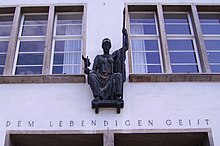
In 1928 the construction of a third bridge over the Neckar began, the Ernst-Walz-Brücke . It is named after the previous mayor. In 1930 donations from US citizens enabled the laying of the foundation stone for the lecture hall building of the New University . In the meantime, efforts were made to promote tourism through targeted measures: the Heidelberg Theater Festival was brought into being in the 1920s, but it failed after only four seasons for financial reasons in 1930. Attempts to make Heidelberg a health resort were also unsuccessful, even if a healing spring opened in 1928 was used as a radium brine spring for almost three decades .
In 1925 a local branch of the NSDAP in Heidelberg was founded. Even during the Weimar Republic, the fascist party on the Neckar achieved above-average results: In the state elections in 1929, their share of the vote, at 14.5%, was twice as high as the national average; in the Reichstag elections in 1930 , the NSDAP was in Heidelberg with 25.2% the strongest party. A controversial figure in the history of Heidelberg is Carl Neinhaus , who was elected mayor in 1928 . In 1933 he joined the NSDAP and remained in office until 1945. Despite his National Socialist past, the politician , who had meanwhile converted to the CDU, served as head of the city again from 1952 to 1958.
time of the nationalsocialism
Shortly after the National Socialists came to power on January 30, 1933, organized discrimination against Jews and other “non-Aryans” began in Heidelberg. On April 5, 1933, Reich Commissioner Robert Wagner issued the “Baden Jewish Decree” two days before the relevant Reich laws. He initiated the compulsory leave of absence for all “non-Aryan” officials. While National Socialism enjoyed strong support among the Heidelberg city population, anti-Semitic tendencies at Ruprecht-Karls-Universität were not particularly pronounced compared to other universities. For this reason, among other things, the proportion of university teachers of Jewish origin in Heidelberg was particularly high until on April 7, 1933, all “non-Aryans” in the public service were retired against their will. By 1939 the university had lost a third of its faculty for "racial" or political reasons.
While plans by the National Socialists to redesign Heidelberg as a “Reichsausbauort” in a monumental layout with parade streets and a festival hall were not realized, they left the Thingstätte on the Heiligenberg as the most visible structural legacy . It is an open-air theater modeled on Greek theaters on the site of an alleged Germanic cult site. It was built between 1934 and 1935 by the Reich Labor Service and Heidelberg students and was used for propaganda events. The cemetery of honor for the fallen of the First World War was also built above the mountain cemetery during the Nazi era .
As in numerous German university cities, the National Socialist German Student Union (NSDStB) staged a book burn on May 10, 1933 on Universitätsplatz in Heidelberg , and further book burns occurred in June and July in the course of imitation campaigns.
On the evening of November 9, 1938 , the riots against Jews reached a new high point. That night Heidelberg citizens burned down the synagogues in Heidelberg and Rohrbach; the orthodox prayer room in the Plöck was also destroyed. The next day the systematic deportation of Heidelberg Jews began with the deportation of 150 Jewish fellow citizens to the Dachau concentration camp . About two years later, on October 22, 1940, the " Wagner-Bürckel Action " took place. More than 6,000 Jews from Baden, including 280 Heidelberg residents, were deported to the Camp de Gurs internment camp . Three quarters of the deported Jews died in the Gurs camp. In 1942 he was deported to Auschwitz .
Hermann Maas pupil and student, among others in Heidelberg, from 1915 pastor at the Heiliggeistkirche, joined the association for the defense of anti-Semitism in 1932 . He was also involved in the pastors' emergency association from 1933/1934. In 1938 he was head of the “Church Aid Office for Protestant Non-Aryans” in the city, helped all those persecuted for racial reasons and worked closely with the Grüber office in Berlin . With his international contacts, he helped many people classified as Jews or half-Jews to escape until the beginning of the war. Despite being banned from his profession in 1933, he preached against the inhuman policies of National Socialism. In 1943, under pressure from the Nazi regime, he was removed from office by the Baden Evangelical Church Council. He was later deported to France for forced labor. After the liberation in 1945 he resumed his work as a pastor. With his thinking and above all his actions, he was an exception - even as a member of the Confessing Church . In 1950 he was Israel's first official German state guest.
Second World War
Heidelberg was one of the few major German cities to survive the Second World War almost unscathed. The first air raid took place on the night of September 19-20, 1940, when the Pfaffengrund district was hit by bombs. On September 23, 1940, a German air raid on Cambridge took place in retaliation for this attack on Heidelberg . Smaller air raids in 1944 and 1945 also caused only minor damage. - Of the 9,129 residential buildings in Heidelberg, 13 were totally destroyed (0.14%), 32 severely damaged (0.35%), 80 moderately (0.87%) and 200 slightly damaged (2.19%). Of 25,933 apartments, 45 were totally destroyed (0.17%) and 1,420 were damaged (5.47%). The freight yard and the zoo were badly damaged by bombs and artillery fire.
Why Heidelberg was almost spared is not entirely clear. On the one hand, due to the lack of heavy industry, the city was not of major strategic importance; on the other hand, it cannot be ruled out that the Americans had already considered Heidelberg as the location of their headquarters before the end of the war. Only the bridges over the Neckar, including the famous Old Bridge, were blown up by Wehrmacht troops on their retreat on March 29, 1945 in order to hinder the advance of the Allies . A day later the American 63rd Infantry Division marched into the city without encountering any significant resistance.
Post-war and present
post war period
Almost intact Heidelberg attracted many bombed-out and expelled Germans after the Second World War. The population of the city was already 111,800 in 1946, while it had been 85,000 before the war. Heidelberg became part of the American zone of occupation and the location of high command posts for the US Army and NATO . The American authorities expropriated real estate for this, which initially caused displeasure. In the 1950s, two settlements emerged in the south of Heidelberg, the Mark-Twain-Village and the Patrick-Henry-Village , as a place of residence for the American soldiers and their families. The American influence has been strongly felt in the city since then: the city was the seat of the NATO land headquarters in Central Europe and the headquarters of the 7th US Army , the American army broadcaster AFN broadcast from Heidelberg, and thousands of American army members and their families lived in the city.
After the end of the war, Heidelberg initially belonged to the state of Württemberg-Baden , founded in 1945 by the American military government , which was merged into Baden-Württemberg in 1952 after a referendum with the states of Baden and Württemberg-Hohenzollern .
The Ruprecht-Karls-Universität was closed by the American occupation forces in April 1945, after a denazification it resumed teaching in January of the following year as the first West German university. Even before the war, individual university facilities had been relocated from the old town campus to Neuenheim on the other side of the Neckar - for example the Botanical Garden or the Physics Institute (on Philosophenweg ). From 1951 a completely new campus, the Neuenheimer Feld , was built on the western outskirts. In the mid-1970s, the expansion of the 120 hectare site was essentially completed; today it is home to numerous scientific and medical institutes, clinics, research institutes and several student residences.
Heidelberg after 1955
The largest structural project of the post-war period was the relocation of the main train station to its current location. For decades, plans had existed, the countries along the Rohrbacherstraße terminal station with a new transit station to replace. In 1955 the new main train station, at that time the most modern train station in the Federal Republic, was inaugurated around 1.2 kilometers west of the old location after four years of construction. The land used the freed up area for the construction of numerous administrative buildings on the Elector's Complex.
In order to take account of the growing population of Heidelberg, two completely new residential areas were created in the south of the city: In the 1960s, the Boxberg forest park settlement was built for 6,000 residents. In 1975 the Emmertsgrund , designed for 11,000 residents, was completed, which is now considered a problem district. In the same year, Heidelberg's expansion in terms of area was completed with the incorporation of the municipality of Ziegelhausen in the Neckar Valley .

The mayor of Heidelberg, Reinhold Zundel, who was in office from 1966 to 1990, dedicated himself to urban redevelopment. During his tenure, the main street in the old town was converted into a 1.6-kilometer pedestrian zone, and Bismarckplatz was given its current shape. Not all measures were uncontroversial because some old houses fell victim to them. The ban of car traffic from the old town is considered a successful measure today. During the district reform on January 1, 1973, the old district of Heidelberg was combined with the district of Mannheim to form today's Rhein-Neckar district , the seat of which remained the independent city.
In 1967/68, as at many German universities, the student movement of the 1960s culminated in Heidelberg , which expressed political protest against emergency laws, the Vietnam War and others in a variety of actions. The underground organization Red Army Faction carried out two terrorist attacks against American facilities in Heidelberg in the 1970s and 1980s. On May 24, 1972, an explosives attack on US headquarters killed three American soldiers and injured five others. An assassination attempt with a bazooka on the Commander-in-Chief of the US Land Forces in Europe, Frederick James Kroesen , on September 15, 1981 failed.
During the term of office of the first female mayor in southwest Germany, Beate Weber (1990-2006), Heidelberg applied for the castle and the old town to be included in the UNESCO list of world cultural heritage . The application submitted in 2004 was rejected in 2005 and June 2007.
The future of the American military presence in Heidelberg was uncertain. On the one hand, as a result of the changed security policy after the terrorist attacks of September 11, 2001 , the European locations had lost their importance for the US Army. Therefore, the number of soldiers stationed in Western Europe was significantly reduced; In 2013, the headquarters of the land forces was relocated from Heidelberg to Wiesbaden and the entire military administration was withdrawn from Heidelberg by 2015, which resulted in 45 million euros in lower income for the city and development opportunities in residential construction.
Individual evidence
- ^ Tilmann Bechert: The early days up to the Carolingians. In: Elmar Mittler (Ed.): Heidelberg. History and shape. Heidelberg 1996, here pp. 21-25.
- ^ Tilmann Bechert: The early days up to the Carolingians , p. 25 f.
- ↑ Bechert, p. 28.
- ↑ Bechert, p. 32
- ^ Arnold Scheuerbrandt: The rise and fall of Heidelberg in the time of the Electorate of the Palatinate , in: Elmar Mittler (Hrsg.): Heidelberg. History and Shape , Heidelberg 1996, here p. 49.
- ↑ Scheuerbrandt, p. 49.
- ↑ Fink, p. 22
- ↑ Sigrid Gensichen: The Heidelberg Castle , in: Elmar Mittler (Ed.): Heidelberg. History and Shape , Heidelberg 1996, here p. 132.
- ↑ Meinrad Schaab: History of the Electoral Palatinate , Vol. I, Stuttgart 1999, p. 57.
- ↑ Fink, p. 23 f.
- ↑ Scheuerbrandt, p. 50.
- ↑ Fink, p. 22 f.
- ↑ Schaab, Vol. I, p. 15
- ↑ This is supported by the number of documents that were issued in Heidelberg, cf. Fink, p. 29
- ^ Eike Wolgast: The University of Heidelberg in: Elmar Mittler (Hrsg.): Heidelberg. History and Shape , Heidelberg 1996, here p. 286.
- ↑ Wolgast, p. 287.
- ↑ Scheuerbrandt, p. 58.
- ↑ Schaab, Vol. I, p. 123
- ↑ Fink, p. 43
- ↑ Meinrad Schaab: History of the Electoral Palatinate , Vol. II, Stuttgart 1992, p. 25 ff.
- ↑ Ira Mazzoni: Building: The eighth wonder of the world. In: Die Zeit , December 5, 2007.
- ↑ The Electoral Palatinate welcomed immigrants with open arms. in: Rhein-Neckar-Zeitung , May 31, 2015.
- ↑ Fink, p. 71 f.
- ↑ Fink, p. 75
- ↑ Schaab, Vol. II, p. 232
- ↑ Fink, p. 86 f.
- ↑ Fink, p. 96
- ↑ Fink, p. 101
- ↑ Timeline of Heidelberg history from 1900. Heidelberg History Association.
- ^ Fink, p. 120
- ^ Pioneer of the Christian-Jewish dialogue. Website of the city of Heidelberg, accessed on January 1, 2020 .
- ↑ Who was Hermann Maas? Evangelical Church in Heidelberg, accessed on January 1, 2020 .
- ↑ An aerial photo of the fire in the former Hindenburg School from May 10, 1945 gives an overview of the intact old town.
- ^ Erich Keyser: Badisches Städtebuch, Verlag Kohlhammer 1959
- ↑ There are unconfirmed reports from leaflets with the text “We want to spare Heidelberg - because we want to live there”. See Fink, p. 122
- ^ AFN is broadcasting again from Stuttgart , Stuttgarter Zeitung, April 22, 2014
- ↑ Heidelberg will not become a world heritage. In: FAZ.net , June 29, 2007.
- ^ Sabine Müller: The capital becomes the headquarters. In: Frankfurter Rundschau , August 2, 2010; Last appeal: NATO headquarters in Heidelberg is dissolved. In: Welt Online , March 14, 2013.
literature
- Andreas Cser: A short history of the city and University of Heidelberg. G. Braun, Karlsruhe 2007, ISBN 978-3-7650-8337-2 .
- Oliver Fink: A short history of the city of Heidelberg. Pustet, Regensburg 2005, ISBN 3-7917-1971-8 .
- Christoph Mauntel, Carla Meyer, Achim Wendt (eds.): Heidelberg in the Middle Ages and Renaissance. A search for clues in ten walks. Thorbecke, Ostfildern 2014, ISBN 978-3-7995-0520-8 ( excerpt ).
- Elmar Mittler (Ed.): Heidelberg. History and shape. Winter, Heidelberg 1996, ISBN 3-921524-46-6 .
- Richard Benz : Heidelberg. Destiny and spirit. 2nd Edition. Thorbecke, Sigmaringen 1975, ISBN 3-7995-4008-3 .
- Meinrad Schaab: History of the Electoral Palatinate.
- Vol. 1. Middle Ages. Kohlhammer, Stuttgart 1999, ISBN 3-17-015673-X .
- Vol. 2. Modern times. Kohlhammer, Stuttgart 1992, ISBN 3-17-009877-2 .
- Dietrich Lutz: Archeology and city history in Heidelberg. In: Denkmalpflege in Baden-Württemberg , 16th year 1987, issue 4, pp. 201–208 ( PDF; 11.5 MB ).
-
Preservation of monuments in Baden-Württemberg , year 38, 2009, issue 1 ( PDF; 8.5 MB ):
- Folke Damminger: Heidelberga deleta. Insights into the archaeological dimension of the city's history. Pp. 4-10.
- Hermann Diruf: Heidelberga aedificata. Insights into the architectural dimension of the city's history. Pp. 11-16.
Web links
- History in numbers. Heidelberg.de
- Brief history of Heidelberg. Heidelberg History Association
- Norbert Emmerich: SEHUM: Swiss immigrants in Heidelberg and the surrounding area. Genealogical database




